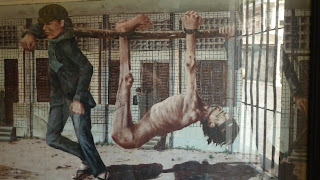The Tuol Sleng genocide Museum is a museum in Phnom Penh. The site is a former high school which was used as the notorious Security Prison 21 (S-21) by the Khmer Rouge communist regime from its rise to power in 1975 to its fall in 1979.

The five buildings were converted into a prison and interrogation centre four months after the Khmer Rouge won the civil war in August 1975.
The barbed wire surrounded the building to stop prisoners commiting suicide, we can't begin to imagine the pain they must have been going through.

Construction began to adapt the prison to the inmates: the buildings were enclosed in electrified barbed wire, the classrooms converted into tiny prison and torture chambers, and all windows were covered with iron bars and barbed wire to prevent escapes.

From 1975 to 1979, an estimated 17,000 people were imprisoned at Tuol Sleng (some estimates suggest a number as high as 20,000, although the real number is unknown). At any one time, the prison held between 1,000–1,500 prisoners

Upon arrival at the prison, prisoners were photographed and required to give detailed autobiographies, beginning with their childhood and ending with their arrest. After that, they were forced to strip to their underwear, and their possessions were confiscated. The prisoners were then taken to their cells. Those taken to the smaller cells were shackled to the walls or the concrete floor. Those who were held in the large mass cells were collectively shackled to long pieces of iron bar. The shackles were fixed to alternating bars; the prisoners slept with their heads in opposite directions. They slept on the floor without mats, mosquito nets, or blankets. They were forbidden to talk to each other.
The prisoners were numbered and tagged , there are thousands of these pictures, you can see the fear in their eyes - its awful.
Out of an estimated 17,000 people imprisoned at Tuol Sleng, there were only seven known survivors, only four of them are thought to be still alive. All three of the men were kept alive because they had skills their captors judged to be useful. Vann Nath had trained as an artist and was put to work painting pictures of Pol Pot. Many of his paintings depicting events he witnessed in Tuol Sleng are on display in the Tuol Sleng Genocide Museum today
This is one of many painting showing the type of torture used at S-21.

In 1979, the prison was uncovered by the invading Vietnamese army. These are the 14 graves of the last prisoners to die at S-21.
A sad day but very much a part of Cambodian life even today.




No comments:
Post a Comment